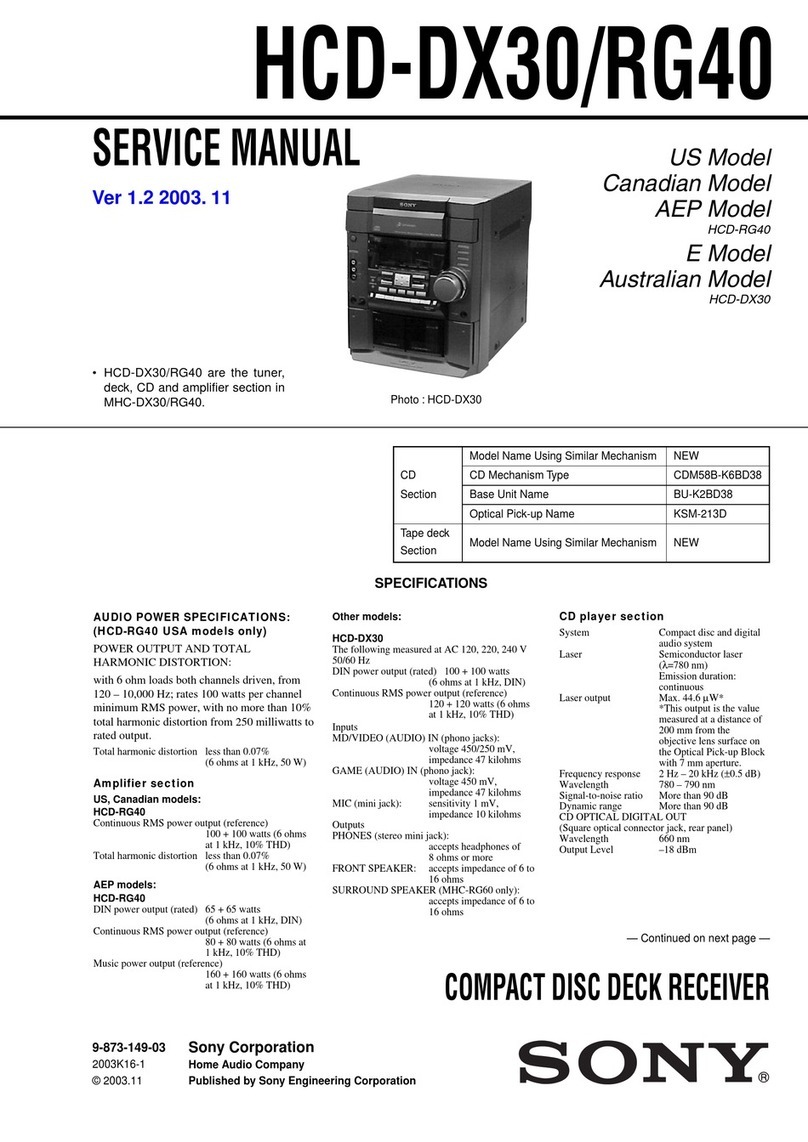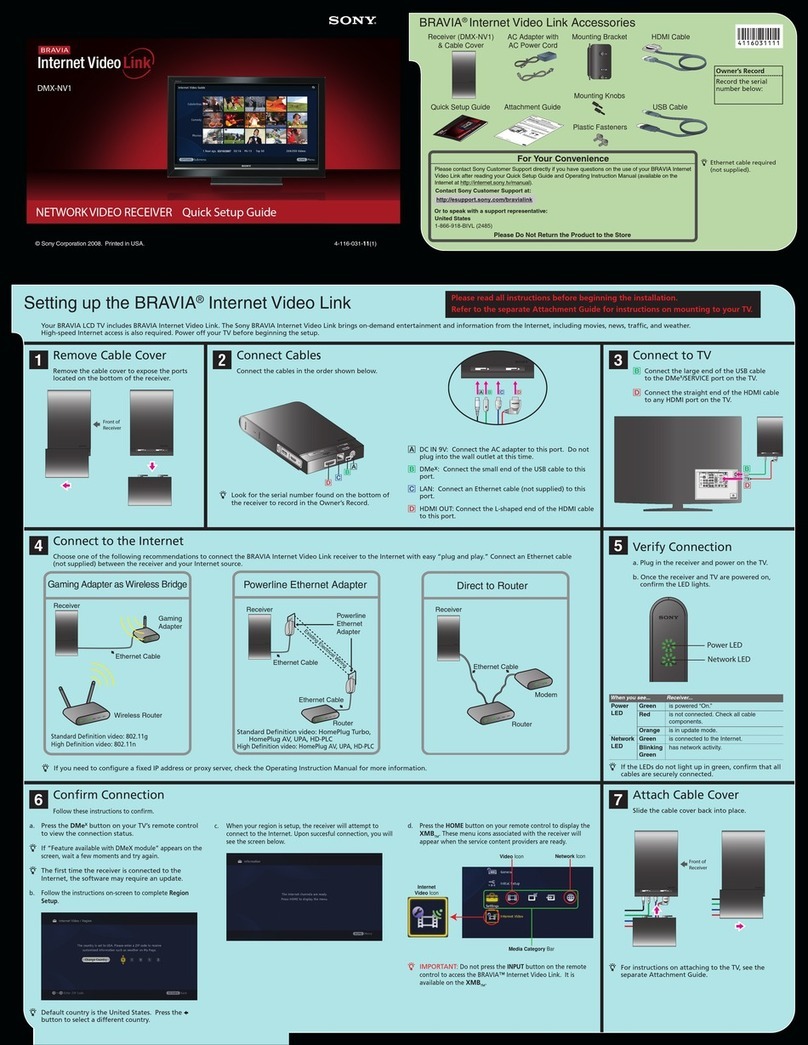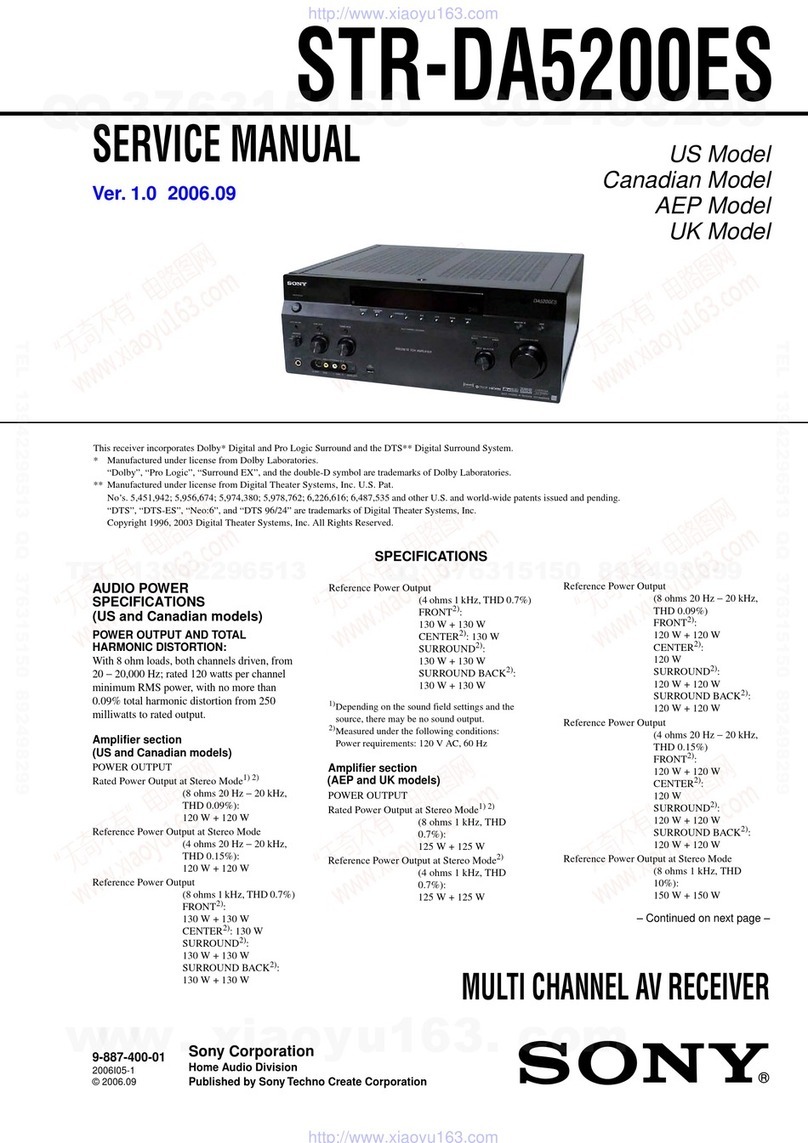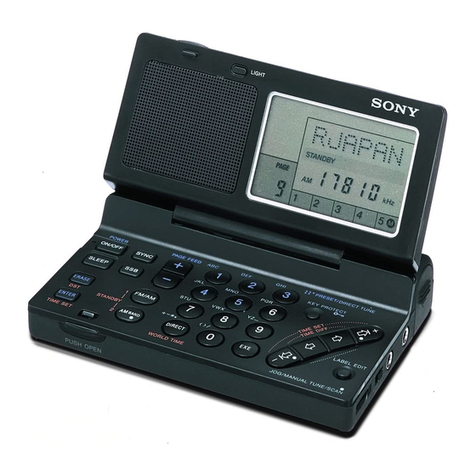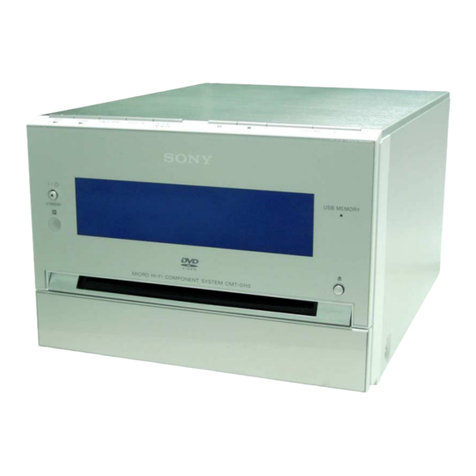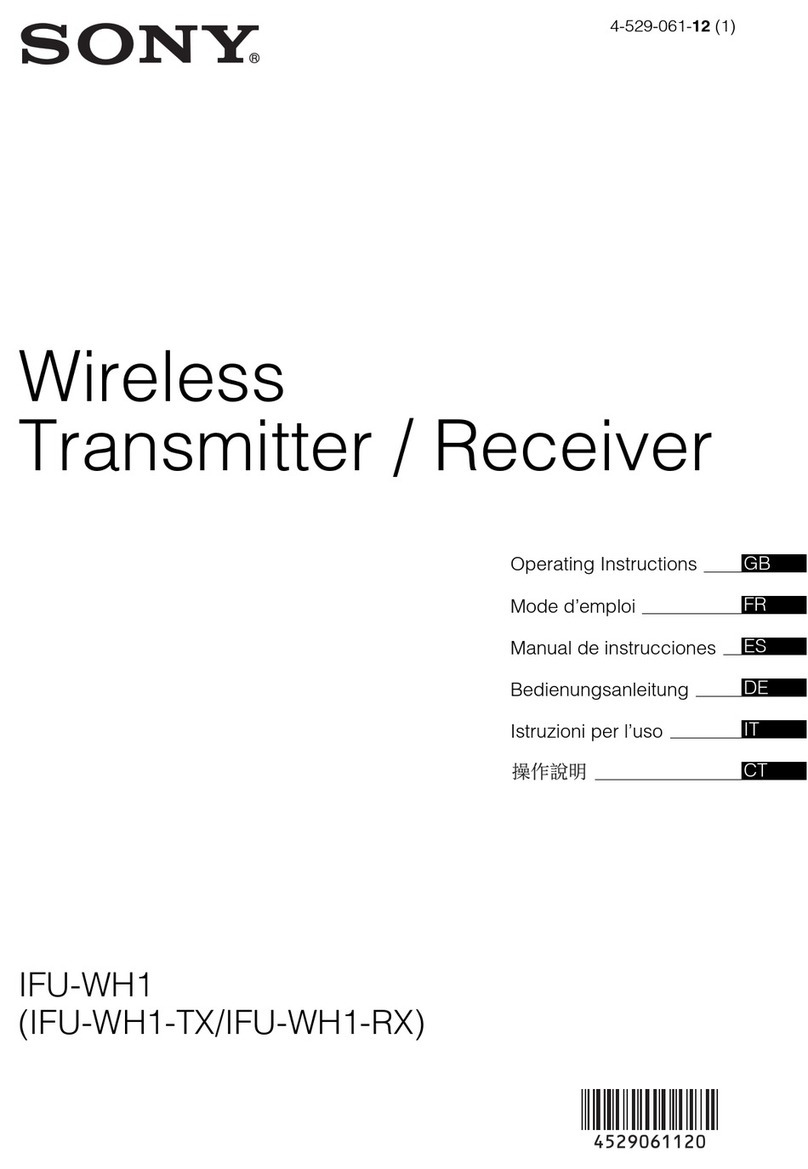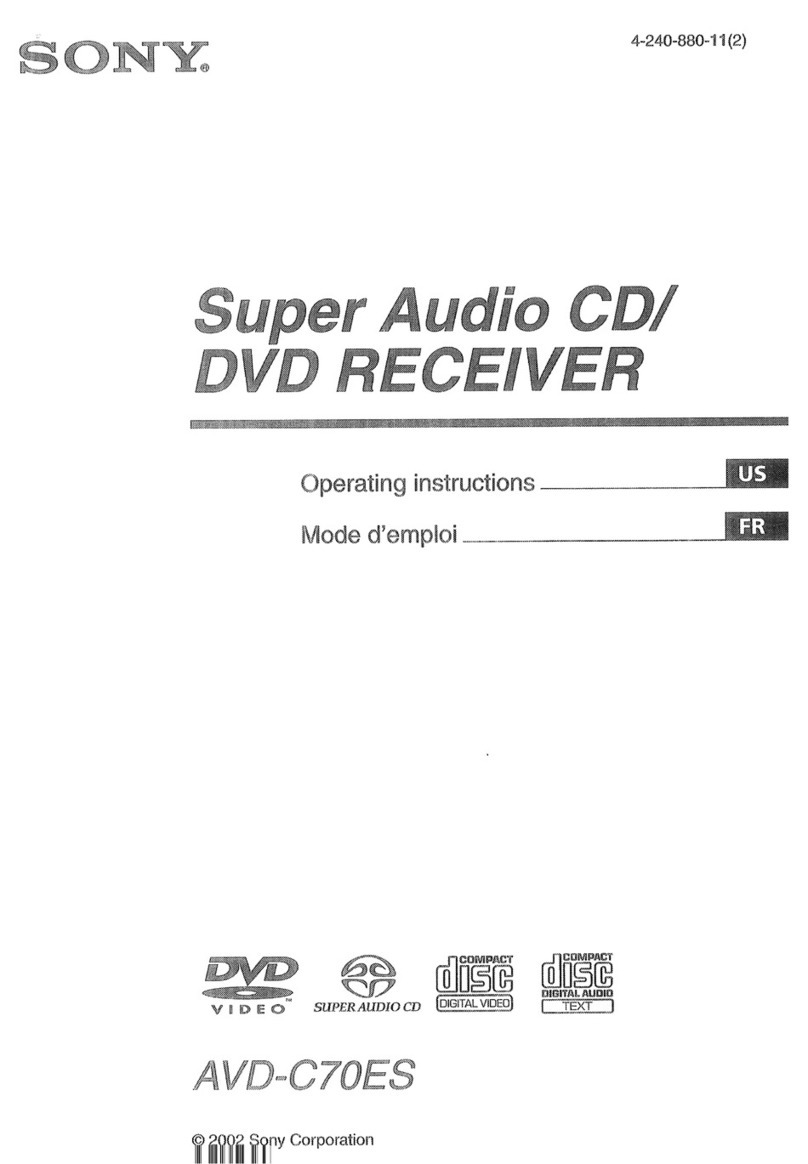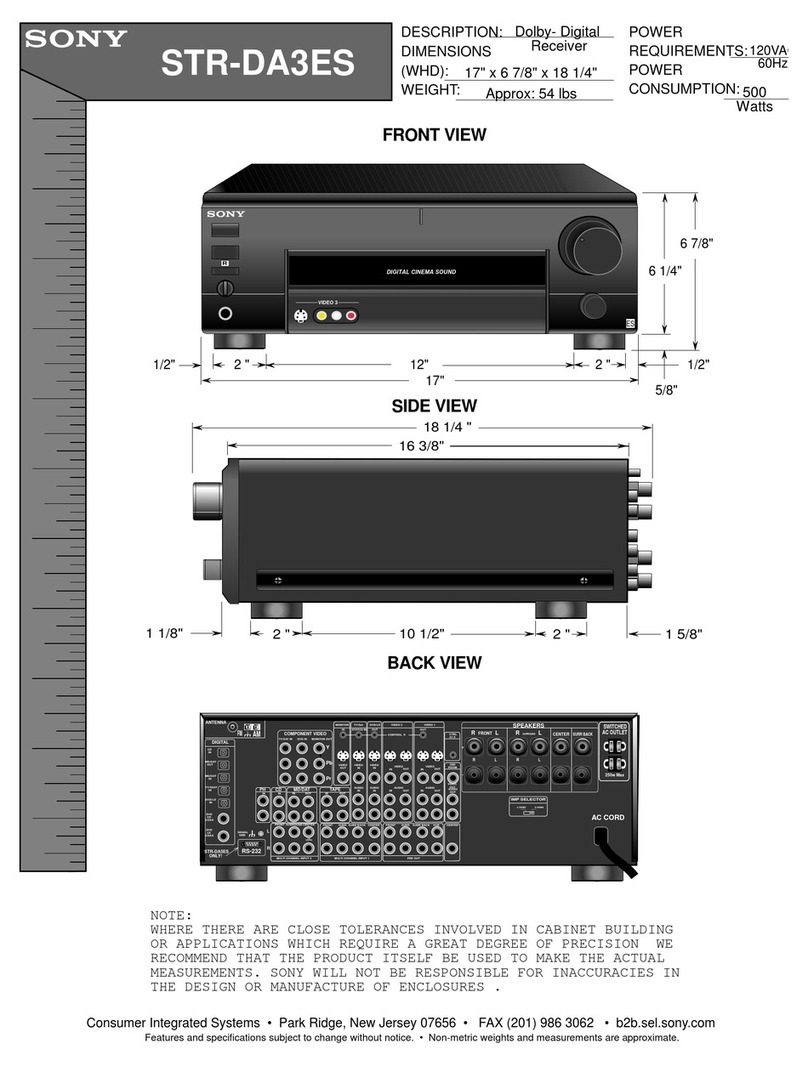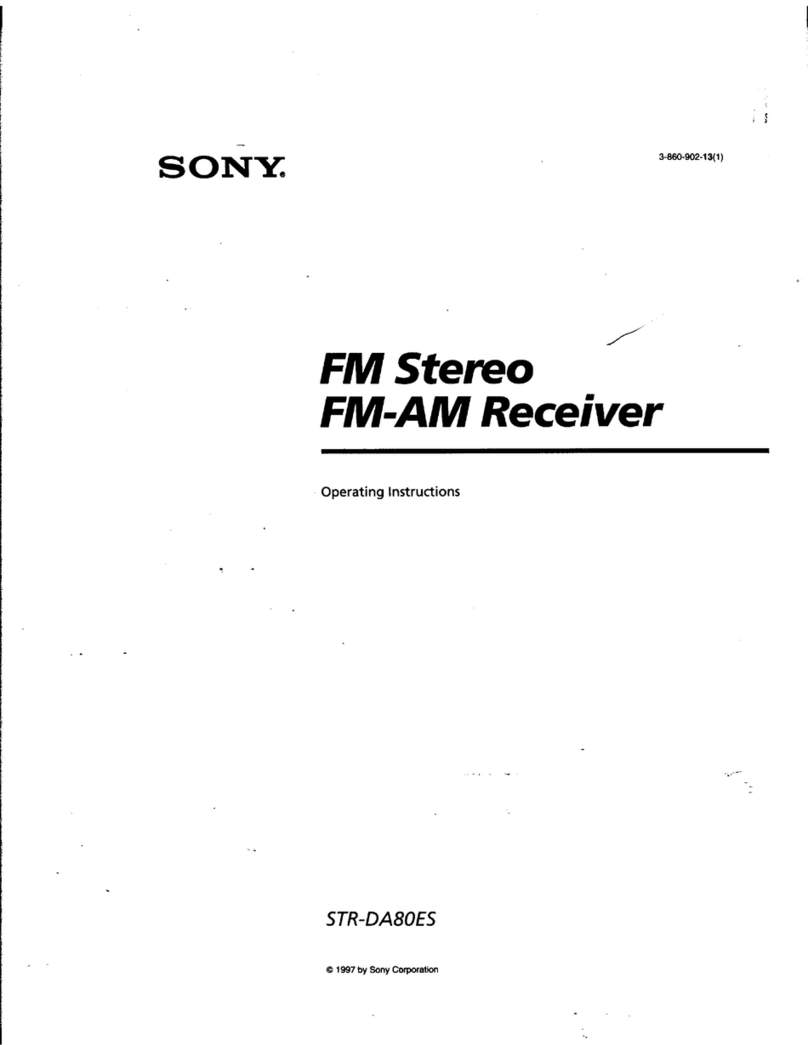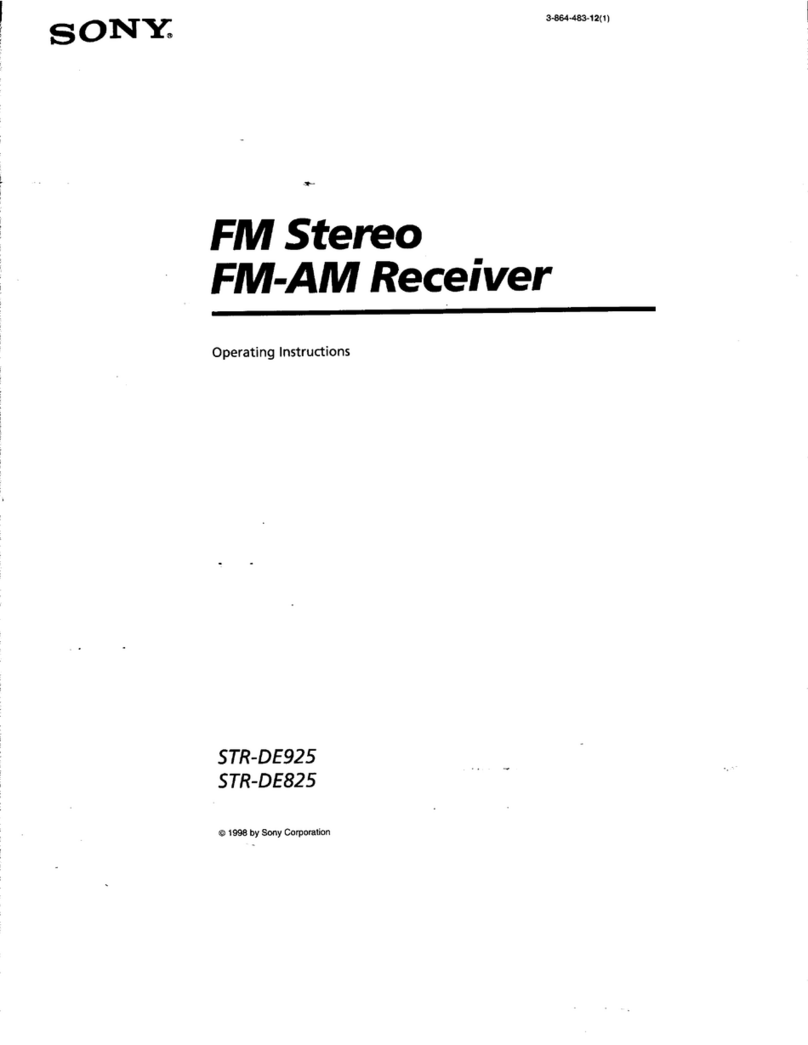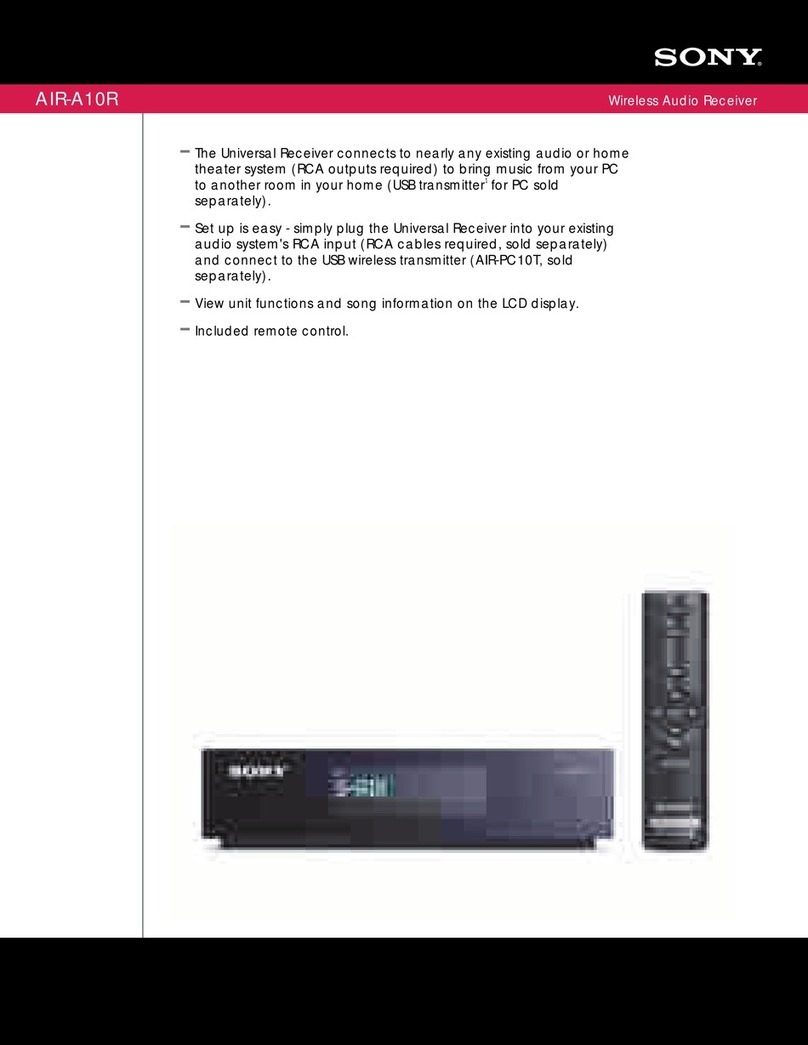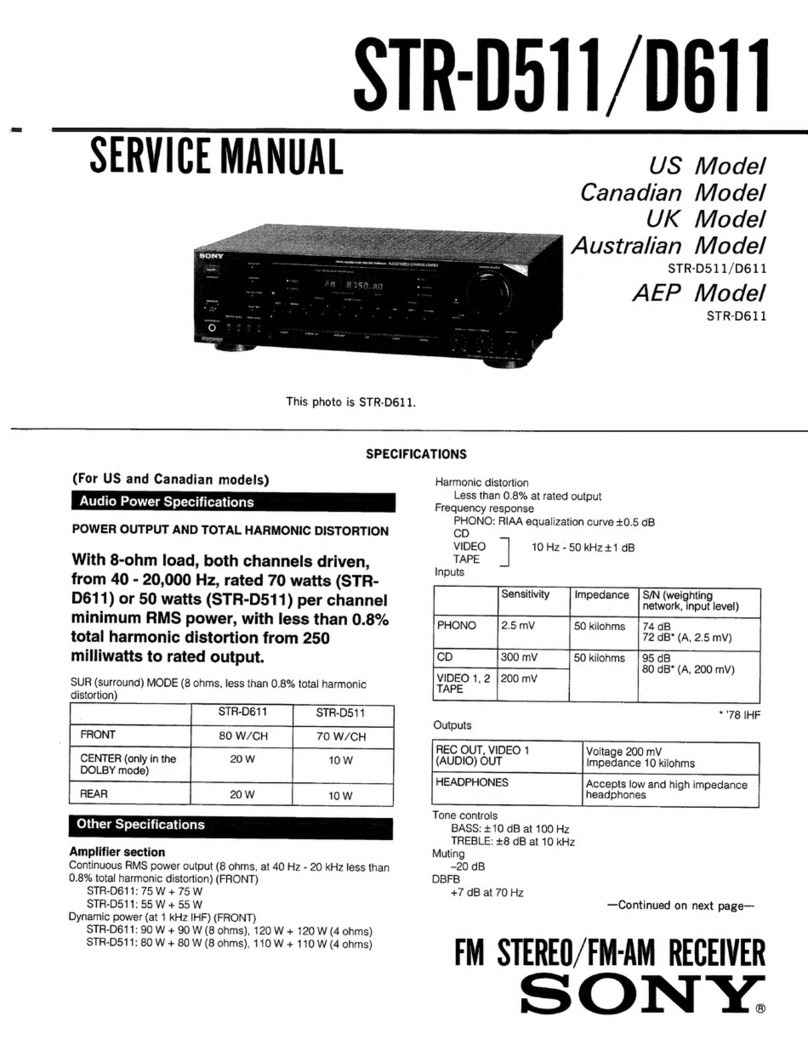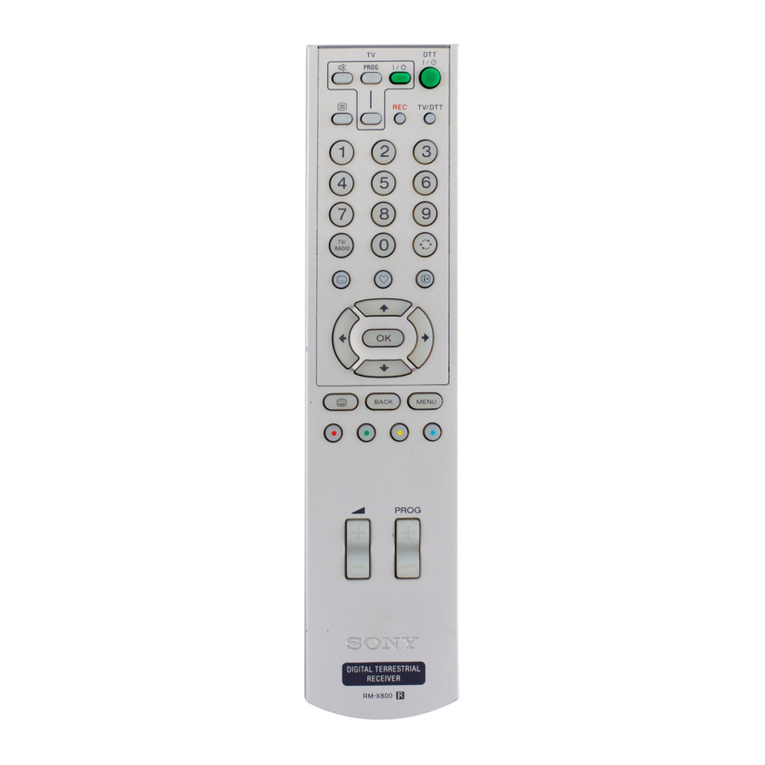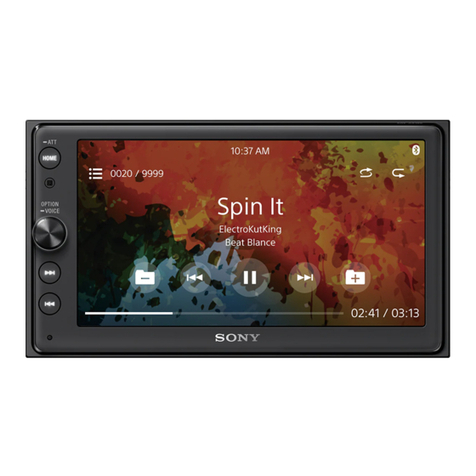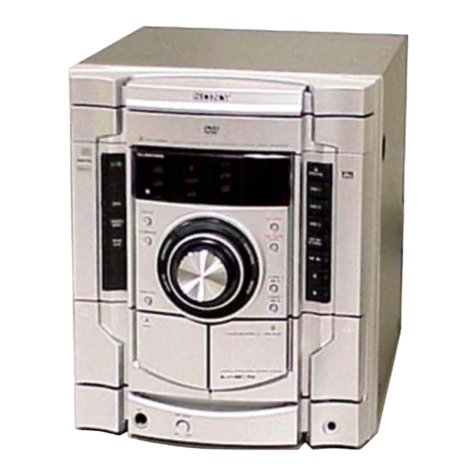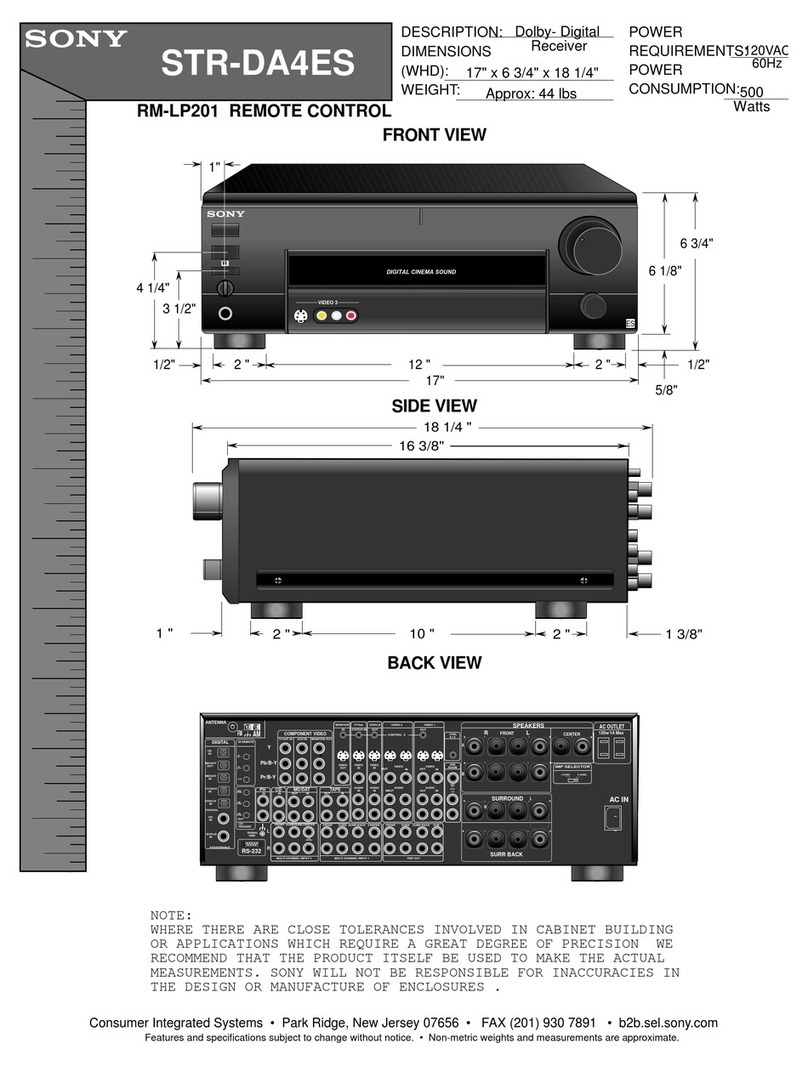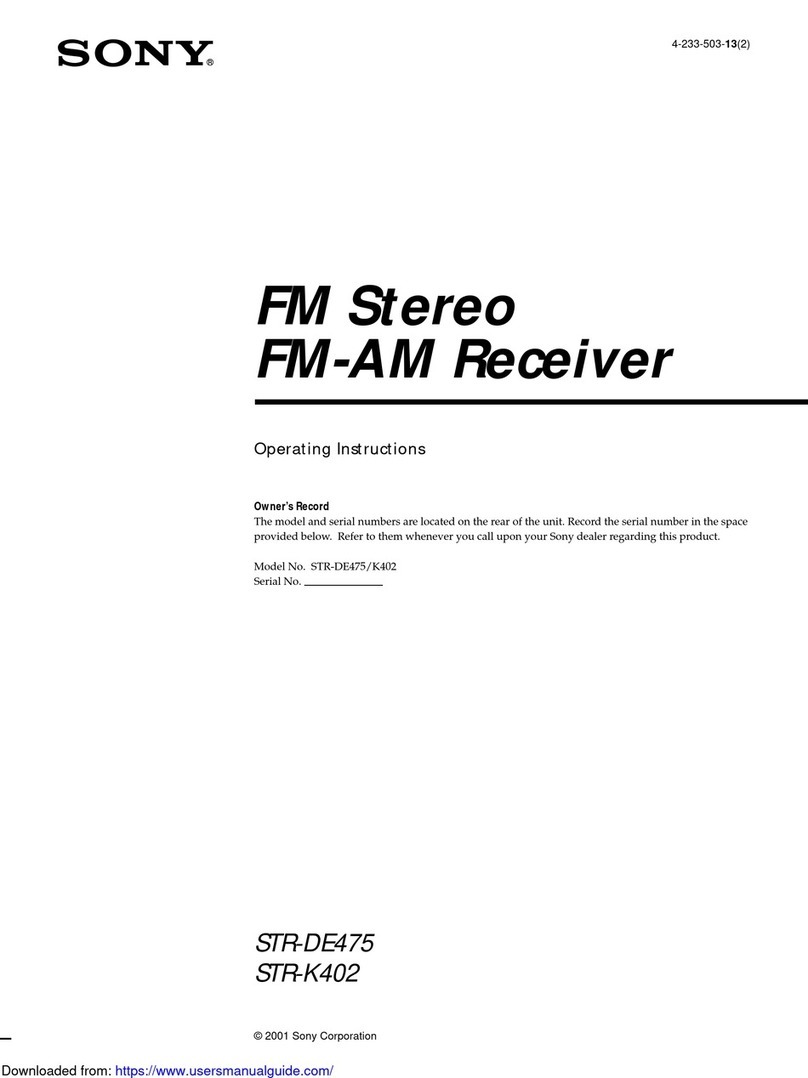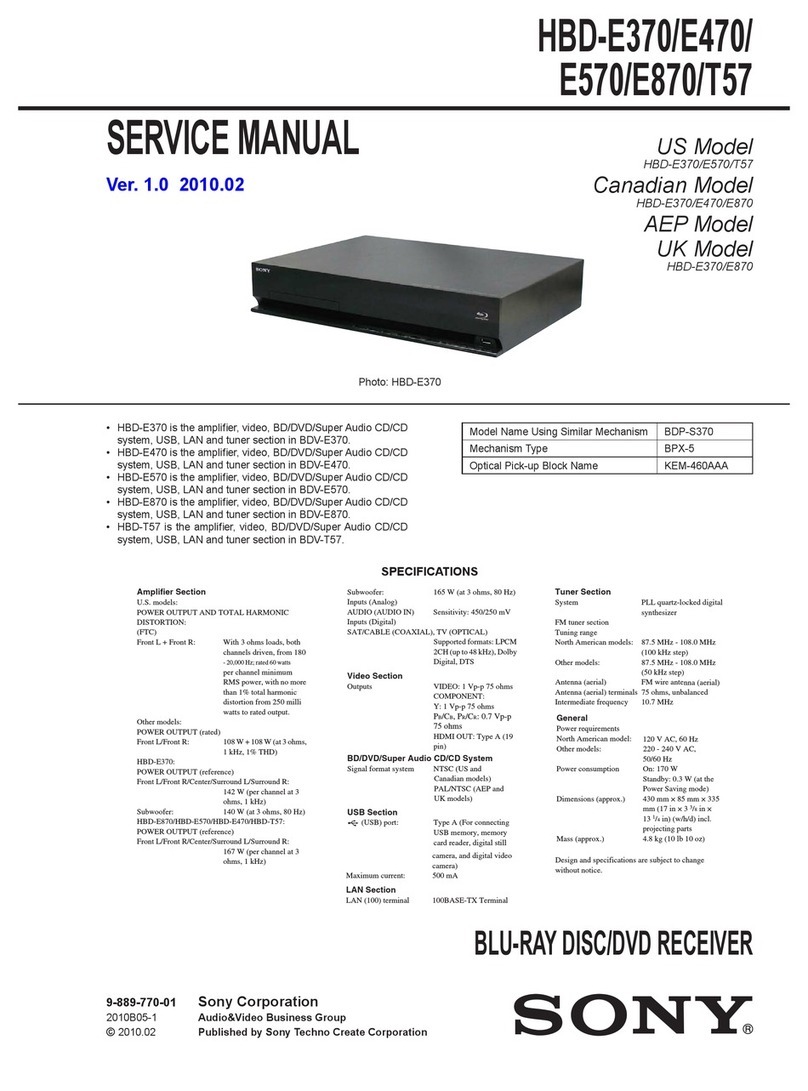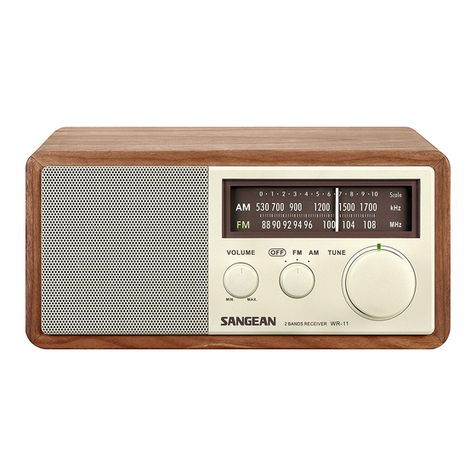5
STR-DG910
SECTION 1
GENERAL This section is extracted
from instruction manual.
US, Canadian model:
5
US
Getting Started
Description and location of parts
.
Getting Started
Front panel
?/1
AUTO CAL MIC
SPEAKERS
(OFF/A/B/A+B)
PHONES VIDEO 3 IN/PORTABLE AV IN
VIDEO L AUDIO R
MEMORY/
ENTER CATEGORY
MODE CATEGORY 2CH A.F.D. MOVIE MUSIC AUTO CAL DIRECT
INPUT SELECTOR
TONE MODE
TUNINGTONE
6 74 8
qs
qd
1 32 59q; qa
qfqgw; qhqlwa qjqk
TUNING MODE
MULTI CHANNEL DECODING
DISPLAY INPUT MODE
MASTER VOLUME
?/1
AUTO CAL MIC
SPEAKERS
(OFF/A/B/A+B)
PHONES VIDEO 3 IN/PORTABLE AV IN
VIDEO L AUDIO R
MEMORY/
ENTER CATEGORY
MODE CATEGORY 2CH A.F.D. MOVIE MUSIC AUTO CAL DIRECT
INPUT SELECTOR
TONE MODE
TUNINGTONE
6 74 8
qs
qd
1 32 59q; qa
qfqgw; qhqlwa qjqk
TUNING MODE
MULTI CHANNEL DECODING
DISPLAY INPUT MODE
MASTER VOLUME
?/1
AUTO CAL MIC
SPEAKERS
(OFF/A/B/A+B)
PHONES VIDEO 3 IN/PORTABLE AV IN
VIDEO L AUDIO R
MEMORY/
ENTER CATEGORY
MODE CATEGORY 2CH A.F.D. MOVIE MUSIC AUTO CAL DIRECT
INPUT SELECTOR
TONE MODE
TUNINGTONE
6 74 8
qs
qd
1 32 59q; qa
qfqgw; qhqlwa qjqk
TUNING MODE
MULTI CHANNEL DECODING
DISPLAY INPUT MODE
MASTER VOLUME
Name Function
A?/1
(on/standby) Pressto turn thereceiveron
or off (page 32, 43, 44, 66).
BSPEAKERS
(OFF/A/B/A+B) Press to select the speaker
system (page 33).
CTONE MODE Adjusts the tonal quality
(bass/treble level) of the
front speakers.
Press TONE MODE
repeatedly to select bass or
treble level, then turn
TONE +/– to adjust the
level (page 46).
TONE +/–
DTUNING MODE Press to select the tuning
mode (page 67, 69, 72–74).
ETUNING +/– Turn to scan a station (page
67, 69, 72–74).
Name Function
FDisplay The current status of the
selected component or a list
of selectable items appears
here (page 7).
GMULTI
CHANNEL
DECODING lamp
Lights up when multi
channel audio signals are
decoded (page 44).
HRemote sensor Receives signals from
remote commander.
IDISPLAY Press to select information
displayed on the display
(page 74, 83).
JINPUT MODE Press to select the input
mode when the same
components are connected
to both digital and analog
jacks (page 78).
continued
6
US
Name Function
KMASTER
VOLUME Turn to adjust the volume
level of all speakers at the
same time (page 40, 41, 43,
44).
LDIRECT Press to listen to high
quality analog sound (page
65).
MAUTO CAL Press to activate the Auto
Calibration function (page
36).
NINPUT
SELECTOR Turn to select the input
source to playback (page
41).
O2CH Press to select a sound field
(page 60, 62, 65).
A.F.D.
MOVIE
MUSIC
PCATEGORY +/– Press to select a category
for XM Radio (page 74).
QCATEGORY
MODE Press to select the category
mode for XM Radio (page
73).
RMEMORY/
ENTER Press to store a station or
enter the selection when
selecting the settings (page
32, 68, 75).
SVIDEO 3 IN/
PORTABLE AV
IN jacks
Connects to a camcorder or
video game (page 28, 41).
TPHONES jack Connects to headphones
(page 94).
UAUTO CAL MIC
jack Connects to the supplied
optimizer microphone for
the Auto Calibration
function (page 35).
7
US
Getting Started
About the indicators on the display
SBRSBL SB
SW
LFE
SP B
LC
SL S
R
SR
SP A
;
D EX
;
PL IIx
;
PL OPT DTS
-ES 96/24
COAXHDMI NEO:6 MEMORY STCAT MONOD.RANGE
1 2 3 4 5 76 8 qaq;9
qsqdqj qgqh qf
Name Function
ASW Lights up when sub woofer is
set to “YES” (page 48) and the
audio signal is output from the
SUB WOOFER jacks.
BLFE Lights up when the disc being
played back contains an LFE
(Low Frequency Effect)
channel and the LFE channel
signal is actually being
reproduced.
CSP A/SP B Lights up according to the
speaker system used (page 33).
However, these indicators do
notlightup ifthespeakeroutput
is turned off or if headphones
are connected.
D; D (EX) Lights up when the receiver is
decodingDolby Digitalsignals.
“; D EX” lights up when the
receiver is decoding Dolby
Digital Surround EX signals.
Note
When playing a Dolby Digital
format disc, be sure that you
have made digital connections
and that INPUT MODE is not
set to “ANALOG” (page 78).
Name Function
E; PL II (x) Lights up when the Pro Logic II
Movie/Music/Game decoder is
activated.
“; PL IIx” lights up when the
Pro Logic IIx Movie/Music/
Game decoder is activated.
However, these indicators do
not light up if both the center
and surround speakers are set to
“NO” (page48) and youselect a
sound field using the A.F.D.
button.
Note
Dolby Pro Logic IIx decoding
does not function for signals
with a sampling frequency of
more than 48 kHz.
F; PL Lights up when the receiver
applies Pro Logic processing to
2 channel signals in order to
output the center and surround
channel signals.
However, these indicators do
not light up if both the center
and surround speakers are set to
“NO” (page48) and youselect a
sound field using the A.F.D.
button.
GOPT Lights up when INPUT MODE
is set to “AUTO IN” and the
source signal is a digital signal
being input through the
OPTICAL jack, or when
INPUT MODE is set to “OPT
IN” (page 78).
continued
8
US
Name Function
HDTS (-ES)/
(96/24) Lights up when the receiver is
decoding DTS signals.
“DTS-ES” lights up when the
receiver is decoding DTS-ES
signals.
“DTS96/24” lightsup when the
receiver is decoding DTS 96
kHz/24 bit signals.
Note
When playing a DTS format
disc, be surethat you have made
digital connections and that
INPUT MODE is not set to
“ANALOG” (page 78).
ICAT Lights up when category mode
is set to “ONE CAT” during
XM Radio operation (page 73).
JMEMORY Lights up when a memory
function, such as Preset
Memory (page 68), etc., is
activated.
KTuner
indicators Lights up when using the
receiver to tune in radio stations
(page 66), etc.
LPreset
station
indicators
Lights up when using the
receiver to tune in preset radio
stations. For details on
presetting radio stations, see
page 68.
MD.RANGE Lights up when dynamic range
compression is activated (page
46).
NNEO:6 Lights up when DTS Neo:6
Cinema/Music decoder is
activated (page 61).
OCOAX Lights up when INPUT MODE
is set to “AUTO IN” and the
source signal is a digital signal
being input through the
COAXIAL jack, or when
INPUT MODE isset to “COAX
IN” (page 78).
PHDMI Lights up when the receiver
recognizes a component
connected via a HDMI IN jack
(page 21).
Name Function
QPlayback
channel
indicators
L
R
C
SL
SR
S
SBL
SBR
SB
The letters (L, C, R, etc.)
indicate the channels being
played back. The boxes around
the letters vary to show how the
receiver downmixes the source
sound (based on the speaker
settings).
Front Left
Front Right
Center (monaural)
Surround Left
Surround Right
Surround (monaural or the
surround components obtained
by Pro Logic processing)
Surround Back Left
Surround Back Right
Surround Back (the surround
back components obtained by
6.1 channel decoding)
Example:
Recording format (Front/
Surround): 3/2.1
Outputchannel:When surround
speakers are set to “NO” (page
48)
Sound Field: A.F.D. AUTO
SW
LCR
SL SR
